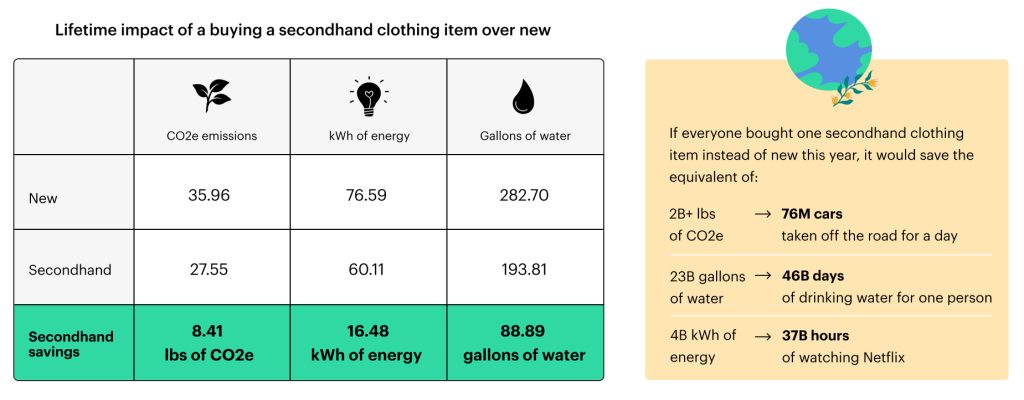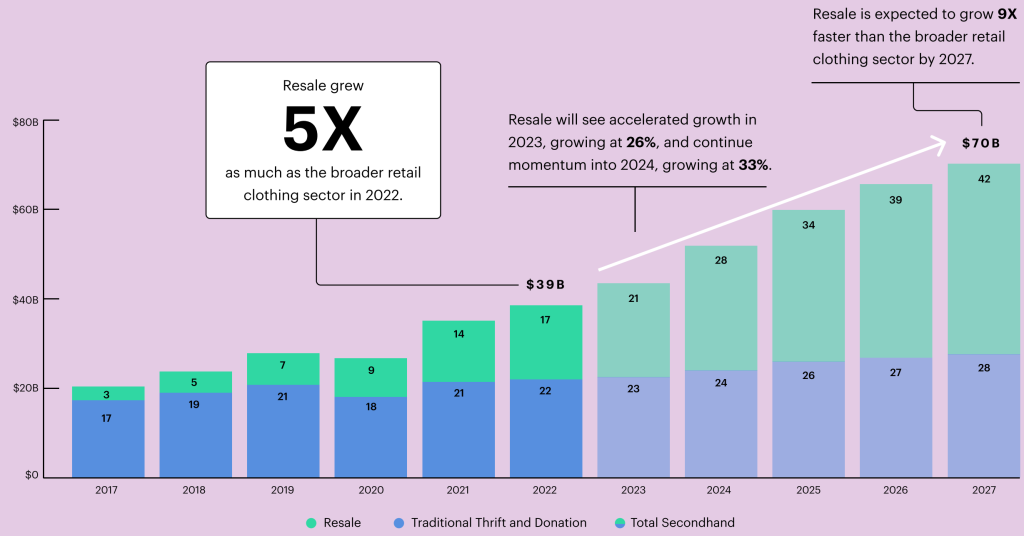In a world obsessed with the latest trends, our wardrobes often mirror the rapid pace of the fashion industry, contributing to a planet drowning in textile waste. Studies show that 85% of textiles end up in landfills annually. In the US this amounts to around 10.5 million tons of waste per year! But what if there were a stylish and sustainable antidote to this eco-chaos? Enter the realm of thrifting – where each pre-loved garment and upcycled furniture piece tells a unique story and every purchase becomes a conscious step towards a greener tomorrow. Join us as we dive into the world of thrifting and explore why it is good for the environment.
An Introduction To thrifting
Thrifting is the act of shopping for second-hand or upcycled items, extending their lifespan and reducing the demand for newly manufactured products. This includes clothing, furniture, and other household items, although our focus here will be on clothing. Typically people ‘thrift’ at flea markets, thrift stores, garage sales, or through online marketplaces. Thrifting comes with many benefits and has been gaining popularity in recent years. Thrifting allows people to find unique and affordable items that would otherwise not be obtainable. This often includes items with retro and vintage aesthetics, styles that are popular, and commonly sought after in the current day.

Source: CertiLogo.
Thrifting also carries with it financial incentives, presenting an affordable option for acquiring high-quality items. Alongside these appeals, thrifting is also good for the environment. Essentially, thrifting reduces waste by giving items a second life. This leads to a significant reduction in pollution that would otherwise result from mainstream fashion.
The Emergence of Fast Fashion
Globalisation enables the production of clothing at ever-decreasing costs, eventually reaching a point where many consumers now see clothing as disposable. Essentially the clothing equivalent of fast food, this trend is often called “fast fashion”. Fast fashion’s mantra of disposable clothing has led to an increased demand for cheap and stylish garments. So, fashion brands have had to find ways to meet this increasing demand. Since the 90s this demand has continued to increase, driven by the growing middle class across the globe with higher disposable income. This increased demand has led to the opening of massive textile mills across the developing world. Workers in these textile mills often work in unsafe conditions. Compensation for these workers is often lacking, and many mills have been known to employ child labour.
A Battle For The Environment – Fast Fashion vs Thrifting
Along with the ethical problems associated with fast fashion, there are also a number of negative environmental impacts. Did you know, that conventionally grown cotton, a commonly used clothing fibre, is one of the most water and pesticide dependent crops? Additionally, polyester, the most widely used manufactured fibre, is made from petroleum. Manufacturing polyester and other synthetic fabrics involves an energy-intensive process that demands large amounts of crude oil. This process releases emissions, including volatile organic compounds, particulate matter, and acid gases like hydrogen chloride. Pollutants such as these are damaging to the environment and have the potential to induce respiratory diseases. In terms of emissions, the fashion industry is responsible for around 10% of global greenhouse gas (GHG) emissions. This exceeds those of the aviation and shipping industries put together.

Source: Earth.ORG.
These examples are just the tip of the iceberg. In reality, there is a long list of negative impacts that arise from the current state of fast fashion. With this in mind, it is clear why many people are beginning to boycott fast fashion and, instead, turn to thrifting or supporting businesses that produce their items locally and on a small scale.
Thrifting And Its Benefits For The Environment
So how good is thrifting for the environment? According to ThredUp’s 2023 resale report, buying and using second-hand clothing, rather than new, reduces carbon emissions by an average of 25%. Below you’ll find a number of environmental benefits that come about when we choose to buy second-hand items instead of supporting fast fashion.

Image source: ThredUp.
Reduction of Textile Waste
Thrift shopping helps to reduce the amount of clothing that ends up in landfill. By giving pre-owned items a second life, consumers can extend the lifespan of clothing and reduce the overall waste generated by the fashion industry.
Resource Conservation
The production of new clothing involves the use of various resources including raw materials, water, and electricity. Opting for second-hand items allows consumers to reduce their demand for new production. As a result, this leads to increased conservation of our precious resources and minimises the environmental footprint associated with textile manufacturing.
Lower Carbon Footprint
The fashion industry is known for its significant carbon emissions, primarily from manufacturing and transportation processes. Thrifting reduces the demand for new production and thus the associated carbon emissions, contributing to lower overall GHG emissions.
Reduction of Land and Waterway Pollution
The production of textiles involves the use of a number of harmful chemicals including harmful dyes, caustic soda, and crude oil by-products. These chemicals are generally dumped after use. This carries a high risk of ground water contamination through soil runoff. Additionally, growing cotton requires large amounts of pesticides, which leads to soil acidification and water contamination.
Promotion of a Regenerative Economy
Buying thrifted and second-hand items promotes a regenerative economy. A regenerative economy is an economic system that aims to retain the value of products, materials, and resources within the economy for an extended period while minimising the generation of waste.
Could Thrifting Be The Future Of Fashion?
It is clear that thrifting brings with it a number of environmental benefits, but could it really be the future of fashion? Results from research conducted by online thrift store ThredUp report that the second-hand clothing market is expected to have grown 9 times faster than the broader retail clothing sector by 2027. In fact, it already grew 5 times faster than the broader retail clothing sector in 2022. ThredUp also reported that one in every three apparel items purchased in the U.S. last year were second-hand. Other organisations report similarly exciting levels of growth. For example, between 2001 and 2006 Goodwill Industries reported a 67% increase in its sale of donated goods, primarily clothing.

Source: ThredUp.
Yet despite the exciting growth of the thrifting sector, there is still a lot to be improved on. Statistics show that charity shops only manage to resell 10 to 30 percent of the second-hand donations they receive. The reality is, there are simply not enough people to absorb the vast quantities of donated and second-hand clothing items that end up on the market each year. Resellers often have to find other ways to make a profit from their second-hand items.
For example, selling to textile recyclers at 10-15 cents per kilogram of clothing. Here textiles are often turned into absorbent wipes, converted to stuffing for upholstery, or used in the manufacturing of paper products. As I hope you’ve seen in this article, thrifting holds many benefits for the environment. So next time you feel the urge to buy clothes perhaps consider the source that you acquire them from! If you’d like to learn more about how much of an impact your fashion habits are having you can use online tools such as ThredUp’s Fashion Footprint Calculator.
Achieving the United Nations Sustainable Development Goals (SDGs) and how they link to the Environmental Benefits of Thrifting
This month The THRIVE Project focuses its sights on the United Nations’ SDG 12 (Responsible Consumption and Production). Thrifting, and the environmental benefits that it carries, have direct links to SDG 12. Thrifting encourages responsible consumption amongst consumers and promotes the idea of a regenerative economy. Additionally, an increased demand for second-hand goods puts pressure on large fashion brands to reduce the scale of their clothing production.
At The THRIVE Project our goal is to advocate for a future in which all life on Earth will not only survive but also thrive. THRIVE examines issues and evaluates potential solutions – making predictive analyses using topics that support environmental and social sustainability transformations. We recognise that human happiness can sometimes compete with environmental well-being. This is why we use our ciambella chart to illustrate the ‘thrivable zone’. THRIVE emphasises the possibility of satisfying environmental, ecological, and social needs concurrently, without having to compromise.
If you would like to learn more about thrivability you can subscribe to our free newsletter. You can also check out our informative podcast series and watch some of our educational Youtube content. Additionally, come along to our webinar events to hear talks from experts in the field of thrivability.